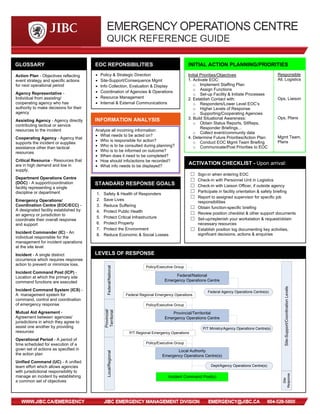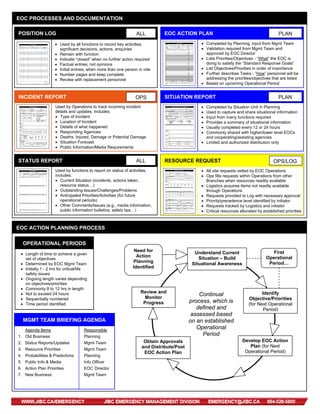Eoc Quick Reference Card April 2010
- 1. LEVELS OF RESPONSE INITIAL ACTION PLANNING/PRIORITIES Initial Priorities/Objectives 1. Activate EOC: o Implement Staffing Plan o Assign Functions o Set-up Facility & Initiate Processes 2. Establish Contact with: o Responders/Lower Level EOCŌĆÖs o Higher Levels of Response o Supporting/Cooperating Agencies 3. Build Situational Awareness: o Obtain Status Reports, SitReps, Responder BriefingsŌĆ” o Collect event/community data 4. Determine Future Priorities/Action Plan: o Conduct EOC Mgmt Team Briefing o Communicate/Post Priorities to EOC STANDARD RESPONSE GOALS 1. Safety & Health of Responders 2. Save Lives 3. Reduce Suffering 4. Protect Public Health 5. Protect Critical Infrastructure 6. Protect Property 7. Protect the Environment 8. Reduce Economic & Social Losses EOC REPONSIBILITIES ŌĆó Policy & Strategic Direction ŌĆó Site-Support/Consequence Mgmt ŌĆó Info Collection, Evaluation & Display ŌĆó Coordination of Agencies & Operations ŌĆó Resource Management ŌĆó Internal & External Communications INFORMATION ANALYSIS Analyze all incoming information: ŌĆó What needs to be acted on? ŌĆó Who is responsible for action? ŌĆó Who is to be consulted during planning? ŌĆó Who is to be informed on outcome? ŌĆó When does it need to be completed? ŌĆó How should info/actions be recorded? ŌĆó What info needs to be displayed? GLOSSARY Action Plan - Objectives reflecting event strategy and specific actions for next operational period Agency Representative - Individual from assisting/ cooperating agency who has authority to make decisions for their agency Assisting Agency - Agency directly contributing tactical or service resources to the incident Cooperating Agency - Agency that supports the incident or supplies assistance other than tactical resources Critical Resource - Resources that are in high demand and low in supply. Department Operations Centre (DOC) - A support/coordination facility representing a single discipline or department Emergency Operations/ Coordination Centre (EOC/ECC) - A designated facility established by an agency or jurisdiction to coordinate their overall response and support Incident Commander (IC) - An individual responsible for the management for incident operations at the site level Incident - A single distinct occurrence which requires response action to prevent or minimize loss. Incident Command Post (ICP) - Location at which the primary site command functions are executed Incident Command System (ICS) - A management system for command, control and coordination of emergency response Mutual Aid Agreement - Agreement between agencies/ jurisdictions in which they agree to assist one another by providing resources Operational Period - A period of time scheduled for execution of a given set of actions as specified in the action plan Unified Command (UC) - A unified team effort which allows agencies with jurisdictional responsibility to manage an incident by establishing a common set of objectives Responsible All, Logistics Ops, Liaison Ops, Plans Mgmt Team, Plans ACTIVATION CHECKLIST - Upon arrival: Ō¢Ī Sign-in when entering EOC Ō¢Ī Check-in with Personnel Unit in Logistics Ō¢Ī Check-in with Liaison Officer, if outside agency Ō¢Ī Participate in facility orientation & safety briefing Ō¢Ī Report to assigned supervisor for specific job responsibilities Ō¢Ī Obtain function-specific briefing Ō¢Ī Review position checklist & other support documents Ō¢Ī Set-up/replenish your workstation & request/obtain necessary resources Ō¢Ī Establish position log documenting key activities, significant decisions, actions & enquiries Incident Command Post(s) Local Authority Emergency Operations Centre(s) Dept/Agency Operations Centre(s) P/T Ministry/Agency Operations Centre(s) Provincial/Territorital Emergency Operations Centre Federal/National Emergency Operations Centre Policy/Executive Group Policy/Executive Group Policy/Executive Group Federal Agency Operations Centre(s) Local/Regional Provincial/ Territorial Federal/National Site Response Site-Support/CoordinationLevels Federal Regional Emergency Operations P/T Regional Emergency Operations
- 2. POSITION LOG ŌĆó Used by all functions to record key activities, significant decisions, actions, enquiries ŌĆó Remain with function ŌĆó Indicate ŌĆ£closedŌĆØ when no further action required ŌĆó Factual entries, not opinions ŌĆó Initial entries, when more than one person in role ŌĆó Number pages and keep complete ŌĆó Review with replacement personnel EOC PROCESSES AND DOCUMENTATION EOC ACTION PLAN ŌĆó Completed by Planning, input from Mgmt Team ŌĆó Validation required from Mgmt Team and approved by EOC Director ŌĆó Lists Priorities/Objectives - ŌĆ£WhatŌĆØ the EOC is doing to satisfy the ŌĆ£Standard Response GoalsŌĆØ ŌĆó List Objectives/Priorities in order of importance ŌĆó Further describes Tasks - ŌĆ£HowŌĆØ personnel will be addressing the priorities/objectives that are listed ŌĆó Based on upcoming Operational Period INCIDENT REPORT Used by Operations to track incoming incident details and updates, includes: ŌĆó Type of Incident ŌĆó Location of Incident ŌĆó Details of what happened ŌĆó Responding Agencies ŌĆó Deaths, Injured, Damage or Potential Damage ŌĆó Situation Forecast ŌĆó Public Information/Media Requirements SITUATION REPORT ŌĆó Completed by Situation Unit in Planning ŌĆó Used to capture and share situational information ŌĆó Input from many functions required ŌĆó Provides a summary of situational information ŌĆó Usually completed every 12 or 24 hours ŌĆó Commonly shared with higher/lower level EOCs and cooperating/assisting agencies ŌĆó Limited and authorized distribution only STATUS REPORT Used by functions to report on status of activities, includes: ŌĆó Current Situation (incidents, actions taken, resource statusŌĆ”) ŌĆó Outstanding Issues/Challenges/Problems ŌĆó Anticipated Priorities/Activities (for future operational periods) ŌĆó Other Comments/Issues (e.g., media information, public information bulletins, safety tipsŌĆ”) RESOURCE REQUEST ŌĆó All site requests vetted by EOC Operations ŌĆó Ops fills requests within Operations from other Branches when resources readily available ŌĆó Logistics acquires items not readily available through Operations ŌĆó Requests provided to Log with necessary approval ŌĆó Priority/precedence level identified by initiator ŌĆó Requests tracked by Logistics and initiator ŌĆó Critical resources allocated by established priorities EOC ACTION PLANNING PROCESS MGMT TEAM BRIEFING AGENDA Agenda Items Responsible 1. Old Business Planning 2. Status Reports/Updates Mgmt Team 3. Resource Priorities Mgmt Team 4. Probabilities & Predictions Planning 5. Public Info & Media Info Officer 6. Action Plan Priorities EOC Director 7. New Business Mgmt Team Continual process, which is defined and assessed based on an established Operational Period Understand Current Situation ŌĆō Build Situational Awareness Identify Objective/Priorities (for Next Operational Period) Develop EOC Action Plan (for Next Operational Period) Obtain Approvals and Distribute/Post EOC Action Plan Review and Monitor Progress Need for Action Planning Identified OPS ALL ALL OPS/LOG PLAN PLAN OPERATIONAL PERIODS ŌĆó Length of time to achieve a given set of objectives ŌĆó Determined by EOC Mgmt Team ŌĆó Initially 1 - 2 hrs for critical/life safety issues ŌĆó Ongoing length varies depending on objectives/priorities ŌĆó Commonly 8 to 12 hrs in length ŌĆó Not to exceed 24 hours ŌĆó Sequentially numbered ŌĆó Time period identified First Operational PeriodŌĆ”
- 3. Operations Section Logistics Section Planning Section Finance/Admin Section LiaisonDeputy Director Risk Management Information EOC Director Public Information Media Relations Internal Information Time Procurement Compensation and Claims Cost Accounting Information Technology EOC Support Supply Personnel Transportation Communications Computer Systems Facilities Security Clerical Situation Resources Documentation Advance Planning Demobilization Recovery Technical Specialists Functional Groups Agency/Departement Representatives (Assisting Agencies) Geographical Divisions Special Operations Agency Representatives (Cooperating Agencies) OPERATIONS ŌĆó Communicates with site(s), field personnel & DOCs ŌĆó Supports site ops ŌĆó Implements plans/ strategies ŌĆó Deploys/tracks EOC- issued site resources ŌĆó Coordination of multi- agency/department responses PLANNING ŌĆó Collects, evaluates, displays info ŌĆó Develops Action Plans & SitReps ŌĆó Conducts long-term/ advanced planning ŌĆó Recommends alternative actions ŌĆó Maintains overall resource and event status LOGISTICS ŌĆó Provides technology/ comms support ŌĆó Arranges/manages facilities ŌĆó Establishes transport resources ŌĆó Arranges responder/ personnel support ŌĆó Orders/supplies requested resources FINANCE ŌĆó Monitors response and recovery costs ŌĆó Monitors expenditure process ŌĆó Coordinates compensation & claims ŌĆó Supports contracts & procurement ŌĆó Tracks personnel time ŌĆó Analyzes & estimates overall costs POLICY GROUP ŌĆó Provides overall policy direction ŌĆó Authorizes ŌĆ£declarationŌĆØ/policy directives ŌĆó Provides direction on public information activities ŌĆó May act as official spokesperson DIRECTOR ŌĆó Overall authority/ responsibility for EOC ŌĆó Provides leadership to Mgmt Team ŌĆó Ensures/approves EOC objectives ŌĆó Communicates with Policy Group ŌĆó Initiates Mgmt Team Briefings INFORMATION ŌĆó Establishes/maintains media contacts ŌĆó Coordinates info for release ŌĆó Coordinates media interviews ŌĆó Liaises with other IOs ŌĆó Prepares public info materials ŌĆó Prepares EOC messaging sheets LIAISON ŌĆó Ensures required agencies are in EOC ŌĆó Primary contact with external agencies, other EOCs ŌĆó Assists EOC Director with activities (e.g. briefings, meetings) ŌĆó Maintains regular contact with cooperating agencies RISK MGMT ŌĆó Monitors EOC safety ŌĆó Maintains link with Safety Officers as applicable ŌĆó Identifies/analyses liability/loss exposures ŌĆó Assesses unsafe situations & halts operations if necessary ŌĆó Recommends safety modifications to ops DEPUTY ŌĆó Assumes duties of EOC Director in their absence ŌĆó Ensures efficient internal information/ communication processes ŌĆó Facilitates resolution of internal staffing/ personnel challenges MANAGEMENT STAFF GENERAL STAFF MANAGEMENT TEAM ŌĆō Roles and Responsibilities EOC ORGANIZATIONAL STRUCTURE Operations Section Fire Police Ambulance Health Emergency Social Services Environmental Engineering/ Utilities Operations Section NW Sector NE Sector SE Sector SW Sector Agency/Dept-based Structure Geographical-based Structure NOTE: Ops Section structure should be based on the jurisdictionŌĆÖs organizational needs & the operational requirements of the incident/event.
- 4. Event/Incident Display ŌĆō Key event/incident information for display to EOC personnel PLAN INCIDENT # DATE & TIME PRIORITY TITLE/DESCRIPTION CURRENT STATUS OUTSTANDING ACTIONS/ISSUES Resource Tracking Display ŌĆō High-level resource tracking info for display to EOC personnel PLAN RESOURCE TYPE RESOURCE ID/ CALL SIGN LOCATION/ASSIGNMENT CURRENT STATUS COMMENTS/NOTES Resource Request Tracking Table ŌĆō Used by Log/Ops to track resource requests LOG REQUEST # DATE RECEIVED TIME RECEIVED PERSON REQUESTING CONTACT INFO RESOURCE DESCRIPTION QTY CURRENT STATUS COMMENTS/ NOTES Media Enquiry Tracking Sheet ŌĆō Used by Information Officer to track media enquiries IO TIME MEDIA OUTLET REPORTERS NAME CALLBACK NUMBERS REQUEST/QUESTIONS CALL STATUS/ ACTIONS TAKEN Position Log ŌĆō Used by all functions to record key actions, decisions, request, enquiriesŌĆ”. ALL DATE TIME TO/FROM ACTION/DECISION/ENQUIRY FOLLOW-UP REQUIRED Expenditure Tracking Report ŌĆō Used by all functions to track expenditures FIN ORDER DATE VENDOR/ SUPPLIER LOCATION OF USE GOODS OR SERVICES RECEIVED/PURPOSE ESTIMATED COST PAYMENT METHOD EOC DATA TABLES AND DISPLAYS ADVANCED PLANNING Ō¢Ī Identify/bring forward demobilization issues related to your assigned function Ō¢Ī Ensure incomplete/open actions in position log are reassigned Ō¢Ī Complete/forward all original documentation to Documentation Unit in Planning Ō¢Ī Advise Finance Section of outstanding financial commitments/details Ō¢Ī Return borrowed or acquired equipment/supplies Ō¢Ī Clean-up/organize your work area Ō¢Ī Prepare to participate in post-operational debriefs and/or After Action Report Ō¢Ī Participate in exit interview/debrief Ō¢Ī Close-out position log, forward to Documentation Unit in Planning Ō¢Ī Sign-out of EOC DEMOBILIZATION CHECKLIST When making media statement, EXPRESS: 1. Concern ŌĆō About health & well-being of those involved 2. Action ŌĆō Steps/processes being taken to help people 3. Commitment ŌĆō The goal is to support those impacted ŌĆó Avoid blocking cameras or saying ŌĆ£no commentŌĆØ ŌĆó Stick to the facts ŌĆō no opinions/ speculation ŌĆó If you donŌĆÖt know, offer to find answer ŌĆó DonŌĆÖt comment on investigations of others ŌĆó Only disclose personal/confidential info if authorized ŌĆó DonŌĆÖt forget the local media ŌĆō they will be with you for the long haul! ŌĆó Remember, you have the right to end the interview Helpful Phrases ŌĆ£The most important point isŌĆ”ŌĆØ ŌĆ£That is a matter forŌĆ”ŌĆØ ŌĆ£Before we wrap up, IŌĆÖd like to emphasizeŌĆ”ŌĆØ ŌĆ£That depends. One thing for certain isŌĆ”ŌĆØ ŌĆ£That would be speculation. What I can tell you isŌĆ”ŌĆØ ŌĆ£That is true; however, itŌĆÖs important to rememberŌĆ”ŌĆØ MEDIA STATEMENTS TIME PERIOD PROBABILITIES & PREDICTIONS ISSUES/ CONCERNS RECOMMENDED ACTIONS/PLANS FUNCTION/ AGENCY RESPONSIBLE ANTICIPATED RESOURCES ConsultwithOps&EOCMgmt Teamtodeterminesuitabletime periods(e.g.,6,12,24,72hrs) Basedoncollectiveexperience, evidenceandavailableinformation, whataretheprobabilitiesand predictionsastheeventunfolds duringthespecifiedtimeperiod? Whatspecificissuesorconcernsdo youanticipatewillariseoverthe designatedtimeperiods? Whatarethespecificactionsor plansthatarenecessaryinorderto addresstheissues&concernsthat havebeenidentified? Whatagency,functionordepartment isresponsibleforimplementingthe action/plan?Ifmorethanone,what aretheirspecificobligations? Whatequipment,personneland/or supplieswillberequiredtocarryout therecommendedactions/plans? 04/10




